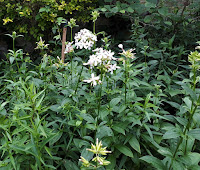July sees a rather different lot of flowers and colours. Whereas June had lots of pink, July has more blue, purple and white. For white there is the splendid white oleander in a pot, a small thicket of saponaria or soapwort, which is actually very pale pink but looks white. (It used to be used for washing clothes.). Then there is my favourite rose, the climbing white Mme Alfred Carrière, a highly scented philadelphus and a white lacecap hydrangea.
 |
| Perennial wallflower |
Blues and purples are supplied by a shrubby salvia called 'Nachtvlinder' next to the late-flowering blue geranium 'Rosanne'. There is also the huge clary sage with its generous leaves and large, loose purple flowers, a deep red astilbe ('Fanal'), a clump of perennial wallflowers in reds and purples and a deep red clematis ('Mme Julia Correvon').
 |
| Clary sage |
 During the sudden downpour at the beginning of the week I was soaked through and through on my five minute walk back from a friend's house. The rain knocked a lot of the flowers about, specially the roses but it was a sort of dead-heading which will do them no harm. I do think though that we had a lucky escape because we probably just got the edge of that horrendous storm that has caused so much damage in Germany.
During the sudden downpour at the beginning of the week I was soaked through and through on my five minute walk back from a friend's house. The rain knocked a lot of the flowers about, specially the roses but it was a sort of dead-heading which will do them no harm. I do think though that we had a lucky escape because we probably just got the edge of that horrendous storm that has caused so much damage in Germany. The square metre patch of wild flowers I planted in the lawn earlier has survived quite well. I see wild geraniums, vetch, red clover and achillea, not flowering yet but on the way. One difficulty is keeping the grass under control because the flowers started as tiny plugs and another the fact that the soil is really too rich for them. In the self sown bit of unmown lawn there are buttercups, daisies, white clover, self heal, wood avens and speedwell and they are visited by bees all the time.
Talking of wild flowers. I have several guidebooks collected over the years. The one I refer to most is The Concise British Flora in Colour, by W. Keble Martin (who spent 60 years on the illustrations and was in his eighties when it was published in 1965). But the other day I found a more up-to-date guide: Collins Complete Guide to British Wild Flowers - 'a photographic guide to every common species' by Paul Sterry (2006) from which I have already been able to identify several flowers.




Comments
Post a Comment